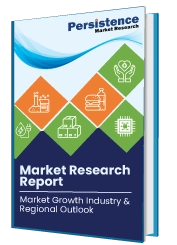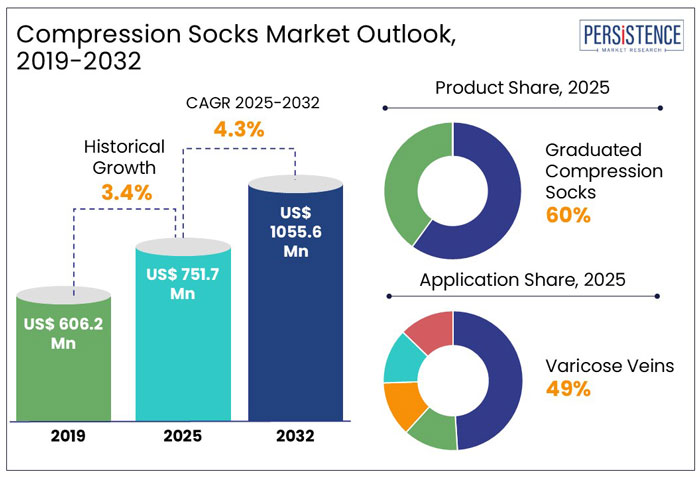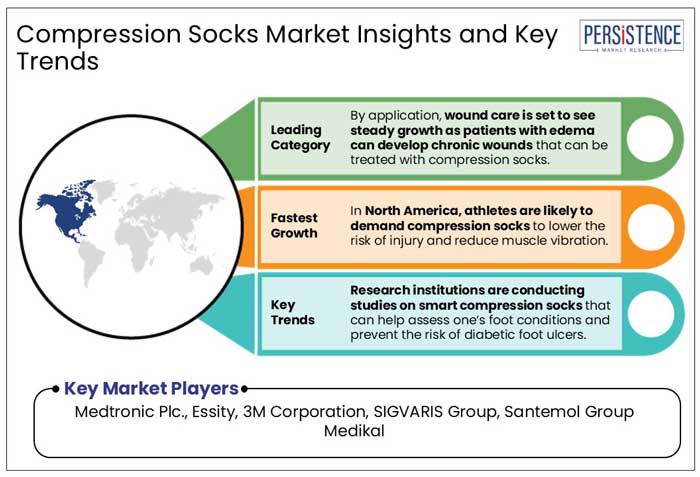ID: PMRREP13648| 180 Pages | 19 Feb 2025 | Format: PDF, Excel, PPT* | Consumer Goods

The global compression socks market size is anticipated to reach a value of US$ 751.7 Mn in 2025 and is set to witness a CAGR of 4.3% from 2025 to 2032. The market will likely attain a value of US$ 1,055.6 Mn in 2032.
Beyond their initial application in healthcare, compression socks have completely transformed both everyday wellness and sports performance. These socks are in high demand, whether it's from athletes looking to enhance their endurance, frequent travelers wanting to relieve swollen legs, or individuals dealing with chronic conditions like varicose veins.
According to Persistence Market Research, compression therapy can increase blood circulation by as much as 40%, which lowers dullness and speeds up recovery. The market is undergoing a dynamic shift due to technical breakthroughs that have included moisture-wicking fabrics, gradient compression designs, and smart monitoring features. The competition is intensifying as companies develop new products to meet a range of consumer requirements, from post-operative recovery to athlete comfort.

Key Highlights of the Compression Socks Industry
|
Global Market Attributes |
Key Insights |
|
Compression Socks Market Size (2025E) |
US$ 751.7 Mn |
|
Market Value Forecast (2032F) |
US$ 1,055.6 Mn |
|
Projected Growth (CAGR 2025 to 2032) |
4.3% |
|
Historical Market Growth (CAGR 2019 to 2024) |
3.4% |
Strategic Marketing Efforts by Companies Raised Awareness of Protective Benefits of Compression Socks
In the historical period from 2019 to 2024, the global compression socks industry witnessed a moderate CAGR of around 3.4%. During this period, it was found that being elderly or having pre-existing health conditions surges one’s risk of severe illnesses or even death from coronavirus.
As per the World Health Organization (WHO), in China, in 2020, around 78% of the cases were among individuals aged between 30 and 69. Also, China’s Center for Disease Control found that out of 44,672 patients investigated for pre-existing medical issues, the fatality rate in those with hypertension was 6.0%, cardiovascular disease was 10.5%, and diabetes was 7.3%.
Medical compression garment companies like Bodyment came to the forefront to create awareness of how wearing medical-grade graduated compression hosiery can help prevent the risk of COVID-19 in those with pre-existing conditions. They conducted research and revealed that high-quality compression socks are designed to exert pressure on the tissue.
It further pushes lymphatic fluid and blood from the bottom of an individual’s legs upwards so it can go back to the heart. They marketed their products by stating that wearing these socks can make a huge difference to one’s vascular health, thereby preventing the risk of COVID-19.
Compression Socks to See High Demand from Patients Suffering from Burns for Scar Management
From 2025 to 2032, the compression socks industry is likely to showcase a CAGR of 4.3%. Patients suffering from burns on their legs are anticipated to create a high demand for these socks in the forecast period due to their significant role in promoting healing and managing scarring.
Significant changes occur in the skin following a burn injury, including the development of hypertrophic scars, which can restrict movement. Over time, compression socks can help to flatten these scars and lessen their visibility by applying controlled pressure to the affected areas.
After recovery, this therapeutic impact is mainly significant for patients who want to regain their skin's appearance and functionality.
Growth Drivers
Medical Recommendations for Post-surgical Care to Propel Compression Sock Sales
Adoption of compression socks is anticipated to rise in post-surgical recovery. These socks have gained impetus worldwide as they help lower the risks of blood clotting and swelling, as well as initiate speedy recovery after liposuction and orthopedic and vein surgery.
According to studies, the risk of deep vein thrombosis is higher than 40% in patients having critical orthopedic surgery. In addition to the possibility of pulmonary embolism and sudden death, deep vein thrombosis frequently results in long-term morbidity. In high-risk individuals, graduated compression socks can effectively reduce the risk of deep vein thrombosis, either alone or in conjunction with pharmacological prophylaxis.
Incorrect Use of Compression Socks Can Lead to Severe Skin Damage and Health Risks
Even though the application of compression socks may seem easy, wearing them incorrectly might lead to serious issues. Particularly in older, malnourished patients and those with thin, brittle skin, uneven distribution and excessive pressure can result in skin damage. For example,
Patients must be appropriately monitored and assessed for suitability of compression stockings. It is also important to ensure the fabric is free of creases so that the pressure is distributed evenly throughout the leg.
Integration of Smart Technology to Improve Effectiveness of Compression Socks in Preventing Foot Conditions
Companies in the global compression socks industry are focusing on investing in research and development to come up with new products to prevent certain conditions like diabetic foot ulcers. For example, researchers at the University of Guelph and Australian University recently conducted a study to assess a smart compression sock manufactured to address the issue of diabetic foot ulcers by integrating blood oxygen sensors, plantar pressure, and temperature.
The socks were tested on 20 healthy adult participants in the age group of 16 to 53 years. Data was collected and stored through a smartphone app. Important changes in blood pressure, temperature, and oxygen were successfully measured by the socks during the evaluation period.
Significant variations were found in statistical studies according to the type of activity and sensor position. These findings demonstrated the sensitivity and precision of the smart sock and raised the possibility that it could help avoid diabetic foot ulcers. Similar studies by research institutes and medical device companies are anticipated to create new avenues for not only the treatment of diabetic foot ulcers but also other foot-related conditions.
Product Insights
Graduated Compression Socks to be Highly Preferred due to Ease of Use and Medical Benefits
By product, the graduated segment is anticipated to hold a compression socks market share of 60% in 2025. Compared to bandaging and pneumatic devices, graduated compression socks are easier to put on and less bulky. Hence, they are frequently prescribed.
Graduated compression socks are usually manufactured under stringent technical and medical specifications, including durability and consistency, to offer a certain level of graduation of compression and ankle pressure. Their use is anticipated to rise to treat patients living with edema and chronic venous disease.
Standard compression socks, on the other hand, are set to witness a steady growth rate in the forecast period. Individuals suffering from minor discomfort or swelling in their legs are likely to opt for standard socks with mild compression level. Mild or class 1 compression (8 to 15 mmHg) socks are recommended for everyday use to prevent fatigue and promote circulation during prolonged standing or sitting.
Application Insights
Compression Socks to Gain Traction as a First-line Therapy for Managing Varicose Veins
In terms of application, the varicose veins segment will likely hold a share of 49% in 2025. For several decades, compression socks have been a standard treatment option for varicose veins. Even today, these are recommended by healthcare professionals as a first-line therapy to manage and prevent the progression of varicose veins.
Modern compression socks are designed to offer constant pressure in the legs, enabling the blood to flow back toward the heart. These socks exert more pressure near the feet and ankles, giving an extra squeeze to support blood flow.
A recent study found that compared to normal socks, wearing compression socks with pressures of 18 to 21 mmHg for 1 week helped to reduce pain and aches associated with varicose veins. Similar findings by various research institutes are set to propel demand for compression hosiery to treat varicose veins.
The wound care segment is projected to remain in the second position in the coming years. Wounds might take a long time to heal when the patient has both edema and a wound. It is possible for those wounds to become chronic.
It is because edema prevents the body from removing damaged tissue and metabolic waste, as well as from bringing new tissue to the injured location. Hence, compression socks are a useful method for promoting wound healing and preventing wounds in patients with edema.

North America Compression Socks Market
North America to Capture High Share due to Compression Socks’ Popularity among Athletes
North America is anticipated to hold a share of 43% in the global market in 2025. Compression socks have become synonymous with athletic performance and health in the region, thereby affecting both recreational and professional athletes. Due to their ability to improve blood circulation, reduce muscle vibration, and lower the risk of injury, compression socks are widely used by athletes in a variety of sports.
The U.S. compression socks market will likely witness considerable growth in the foreseeable future. A survey conducted by the National Athletic Trainers’ Association found that about 57% of athletes in the U.S. reported wearing compression socks during their competitions or training. The survey further mentioned that nearly 85% of athletes believed that these socks helped enhance their recovery time.
Apart from their performance benefits, compression socks have gained immense popularity among athletes in Canada for injury prevention. The Canadian Physiotherapy Association found that athletes wearing compression socks reported a 30% decrease in the occurrence of muscle sprains and strains. Several sports organizations in the country are hence projected to recommend the use of compression socks and stockings as part of standard injury prevention plans.
Latin America Compression Socks Market
Brazil and Argentina to Remain at the Forefront as Popularity of Soccer and Recreational Running Rises
In Latin America, Brazil and Argentina are anticipated to remain at the forefront of the market. In Brazil, compression socks have experienced high demand due to rising emphasis on sports like soccer and volleyball, which are heavily entrenched in the local culture.
A study conducted by Brazilian Society of Sports Medicine indicated that around 40% of athletes, especially in team sports, wear compression socks with to help with recovery. Increasing participation in competitive events and rising awareness of injury prevention are set to create new prospects in the country.
In Argentina, compression socks are gaining traction among cyclists and runners. The Argentine Association of Sports Medicine revealed that nearly 35% of recreational runners wore these socks during their training sessions. Increasing number of half-marathons and marathons across cities like Buenos Aires is projected to boost the market.
Asia Pacific Compression Socks Market
High Risks of Diabetic Foot Ulcers in China and Circulatory Disorders in South Korea Fueling Demand
Asia Pacific is likely to see steady growth trajectory in the upcoming years with China at the forefront. Rising prevalence of diabetes in China is projected to increase the risk of diabetic foot ulcers, thereby creating high demand for compression socks. With about 118 million diabetics, the country has the largest diabetes population in the world, making up around 22% of all diabetics globally.
In South Korea, on the other hand, rising prevalence of circulatory disorders is anticipated to boost demand for compression socks. The Korean National Health Insurance Service stated that nearly 25% of adults suffer from some type of chronic venous insufficiency. Hence, compression socks are being recommended by doctors to manage such conditions.
Leading players in the compression socks industry are focusing on launching new products by joining hands with healthcare professionals. They are also aiming to initiate wholesale programs so that their products are easily accessible among small businesses and retailers.
A few other companies are focusing on strengthening their online presence by extending their portfolios on e-commerce platforms. They are coming up with socks made of innovative materials. Stylish designs, moisture-wicking features, and breathable fabrics are a few developments that key companies are focusing on worldwide.
Key Industry Developments
The market is set to reach US$ 751.7 Mn in 2025.
The industry will likely be valued at US$ 1,055.6 Mn in 2032.
The industry is set to surge at a CAGR of 4.3% through 2032.
Medtronic Plc., Essity, and 3M Corporation are the key manufacturers.
In older, malnourished patients, unevenly distributed and excess pressure may break the skin.
|
Report Attributes |
Details |
|
Historical Data/Actuals |
2019 - 2024 |
|
Forecast Period |
2025 - 2032 |
|
Market Analysis Units |
Value: US$ Bn/Mn, Volume: As applicable |
|
Geographical Coverage |
|
|
Segmental Coverage |
|
|
Competitive Analysis |
|
|
Report Highlights |
|
|
Customization and Pricing |
Available upon request |
By Product
By Application
By End User
By Region
Delivery Timelines
For more information on this report and its delivery timelines please get in touch with our sales team.
About Author